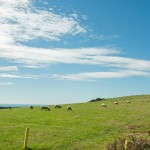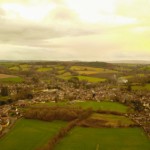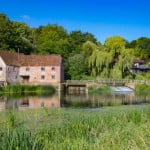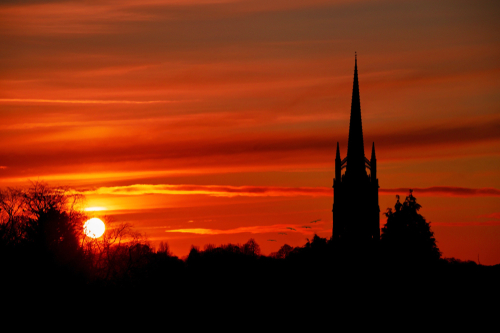
Louth is a market town and civil parish in the East Lindsey district on the edge of the Lincolnshire Wolds on the banks of the River Lud, lying 15 miles (24 km) south of Grimsby and 12 miles (19 km) west of Mablethorpe. Louth also lies directly north of Greenwich on the Prime Meridian. It’s the principal town and economic centre for a largely rural area of East Lincolnshire and is thus, often referred to as the ‘Capital of the Wolds’.
Sound like a place to visit? Then read on and learn a bit more, starting with a bit of history.

Image: Villan/Shutterstock.com
A Fleeting History
Early Days
Its thought Louth started out as an early 6th century Saxon settlement. Some experts think that its name is derived from a corruption of a Saxon word for ‘loud’. The associated noise being generated from the numerous watermills in the area that were driven by the fast-flowing waters of the Lud. Following the arrival of Christianity in Britain, its thought that Louth soon became an important religious centre. Such, that in the late 7th or early 8th century, a monastery was built in the area. However, according to popular belief, the monastery was then destroyed by the marauding Viking Danes. The last Bishop of Lindsey, Herefrith, is said to have died a martyr at the hands of the Norse invaders. Nevertheless, the settlement of Louth went on to thrive under Danish rule, becoming the regions main commerce hub.
The Doomsday Book
By the time of the Norman Conquest of 1066, the town already had an established a weekly market and an annual fair. The Domesday Book of 1086 records that Louth consisted of 124 households, with a population of around 600. In 1139, Louth Park Abbey was founded by Bishop Alexander of Lincoln as a dependency of the Cistercian Fountains Abbey in Yorkshire. By this time, sheep farming was already popular around the hills of the Lincolnshire Wolds. This meant Louth soon went on to develop a flourishing wool trade, aided by the expertise of the local Cistercian monks. The wool industry went on to generate prosperity down the years for Louth’s residents.
There is a written reference to a school being in Louth as early as 1276, made by the schoolmaster of the day, Simon De Luda. However, history suggests there was probably a school in Louth much earlier, which was funded by the town’s religious leaders and merchants. One of the town’s most important buildings, St James’ church, was founded early in the 15th century. Its imposing octagonal tower was added in the early 16th century.
Turbulent Times
In 1536, following the realisation of Henry VII’s Dissolution of the Monasteries Act, Louth Park Abbey was closed. Shortly after, the crown despatched an official to Louth, tasked with valuing the possessions of local religious establishments. However, the official was sent on his way by local residents, who feared that they were about to lose their churches. Rumour of events quickly spread throughout the area, resulting in a meeting being held at St. James Church on 1 October 1536. The upshot was that the residents of Lough decided to revolt and join the growing numbers of the ‘Pilgrimage of Grace’ movement.
The uprising that had started in the North of England, was a movement against King Henry’s break with the Catholic church. Within a few days, up to 50,000 protesters from around the region are said to have marched on Lincoln. However, the rebellion was quickly and brutally suppressed by the King’s forces. The Lincolnshire Uprising ended when local cobbler, Nicholas Melton, and the vicar of Louth, Thomas Kendall, were hanged at Tyburn. In all, 216 people identified as rebel leaders of the insurgence were put to death, which included 38 monks and 16 parish priests. King Henry went on to describe Lincolnshire as, “The most brute and beastly shire of the whole realm.”
Disease and Civil War
In 1551, a grammar school was founded in the town. However, for a time at least, that was the end of the good news. The following decades would see Louth suffer a series of setbacks. The town saw major outbreaks of the plague in 1587, 1625, and 1626. However, the most serious epidemic of the plague occurred in 1631. It’s reported to have killed as many as 700 people, a significant proportion of the town’s population. However, Louth’s residents proved resilient and the town quickly recovered from the trauma of pestilence.
Though within a few years, the English Civil War (1642 to 1649) between the Royalists and the Parliamentarians, saw life in Louth seriously disrupted once again. In 1643, resident nobleman Sir Charles Bolles, raised a local militia to fight for the Royalist cause. Lincolnshire saw several battles and skirmishes, including an incident at Louth which saw several people killed. In October 1643, the Royalists were overwhelmingly defeated by Parliamentarian forces at the Battle of Winceby, taking place just 14 miles from Louth. The victorious roundhead forces were led by none other than Oliver Cromwell himself. The defeat saw the end of the Royalist cause in Lincolnshire, which was to remain in Parliamentarian hands until the end of the war.
18th & 19th Centuries
Through the 18th century, Louth upheld its status as an important market town and continued to thrive. In 1763, an Act of Parliament was passed giving the go-ahead for the construction of the Louth Canal. The 11-mile waterway, constructed between Louth and Tetney Haven on the Humber estuary, was completed in 1770. The privately financed project gave the town some benefit in as much as it became easier to transport goods to and from Louth. However, the canal never became anywhere near the commercial success that its shareholders might have hoped. Down the years, the canal’s operation and maintenance proved to be fraught with problems.
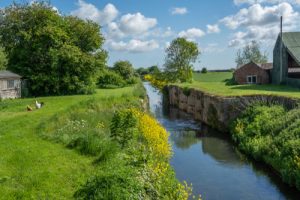
Image: Gill Kennett/Shutterstock.com
Carpet Making
In 1781, a young entrepreneur named Adam Eve took over a draper’s shop at No.1 The Market Place. With the advantage of a ready wool supply, skilled labour, and good transport links, he went on to establish Louth as an important centre for the carpet industry. By 1801, the population of Louth was well over 4,000 representing a fair-sized market town by the standards of the day. Like most of the rest of the country, the residents of Louth began to see a gradual improvement in the quality of life as the century progressed. In 1825, a ‘Board’ was set up by an Act of Parliament that took on responsibility for the paving and cleaning of the town’s roads. In 1836, the town saw further improvements when the streets were lit by gas.
The Railway Arrives
In 1848, the East Lincolnshire Railway Company opened a rail link between Boston with Grimsby, via Louth. The arrival of the railway line saw increased for competition and an eventual death knell for the already struggling canal operation. Yet, despite its transport issues, Louth saw rapid population growth through the first half of the 19th century. During the period 1801 to 1851, the town’s inhabitants grew by 150%, to some 10,000. Coincidentally, the town’s amenities also continued to improve, seeing the town’s first hospital open in 1873.
In 1876, the Louth and Lincoln Railway Company established a branch line westwards from the town to Bardney. The railway was planned mostly for industrial use, i.e. to ship ironstone along the route. However, it was never to be a great commercial success, given that the ironstone deposits did not live up to expectations. In 1877, the Louth and East Coast Railway built a 12 mile branch line from Louth to Mablethorpe to cash-in on the growing seaside tourist industry. In 1888, Mablethorpe Loop Line, as it became known, was completed, linking it to Willoughby. Other improvements saw Hubbard’s Hills public park open in 1907, and Louth Museum in 1910.
The War Years
During WWI, a total of 209 servicemen were killed from the Louth area. On 29 May 1920, Louth was subject to a severe flood of apocalyptic proportions. Dubbed ‘The Great Flood of Louth’, it resulted in the death of 23 people, including 6 children. Fifty houses were also destroyed, and more than 800 people were made homeless. In 1921, a war memorial was erected to honour the town’s fallen from WWI. In 1924, The Louth Canal was finally closed after being in decline for many years. The 1920s also saw the first council houses being built in Louth. From 1935, the town’s streets were lit by electricity.
During WW2, a total of 92 people from Louth were killed. It included 15 civilians who died in two separate German bombing raids that took place on the town in 1941. All the names of the fallen were added to the town’s Imperial War Memorial.
Modern Day Louth
In 1951, the train passenger service to Bardney stopped, with its commercial use ceasing in 1960, following the closure of the line. In 1970, Louth station closed to passengers, along with the Mablethorpe Loop Line.
Today, Louth is noted for its great variety of independent retailers, with around 70% of its businesses being independently owned. In particular, it’s recognised for the quality of its food products. In 2012, it was named ‘Britain’s favourite market town’ by the BBC’s Countryfile programme. The town holds markets on Wednesdays, Fridays and Saturdays, and in addition, there’s a farmers’ market held on the fourth Wednesday of each month. Lincolnshire’s only surviving cattle market is held every Thursday at the Louth Livestock Centre in Newmarket. The town is also home to many of the country’s various vegetable growers associations.

Many of Britain’s vegetable growers associations are based in Louth Image: Baloncici/Shutterstock.com
Getting to Louth
By Road
From the North, the easiest way is probably to take the M180/A180 towards Grimsby, then follow the A18/A16 to Louth. From the Humberside area take the A16 directly to Louth. From the South and Midlands take the M1 or A1, then turn onto the A52 at Nottingham or Grantham, respectively, and then follow to Louth.
By Rail
The nearest railway stations to Louth are Grimsby (12 miles) and Skegness (23 miles). There are regular bus services between both towns and Louth.
By Bus
National Express operate 3 buses a day from London directly to Louth. All three buses leave between 12 noon and 2.30 pm, with a journey time of around 6 hours. You will need to change buses to get Louth from most other destinations in the country.
By Air
The nearest airport to Louth is Humberside which is 26 miles (42 km), however, it has a limited flight schedule. The closest large facility is East Midlands Airport, which 77 miles (123 km) away.
Louth Sporting Attractions
Football
Louth Town FC plays in the Lincolnshire Football League, the 11th tier of English football. Nicknamed ‘The White Wolves’, they play their home games at the Marshlands.
Cricket
Louth Cricket Club, formed in 1822, is Lincolnshire’s oldest team. They play their cricket in Division 1 of the Lincolnshire County League. Home games take place at the London Road sports pavilion.
Motor Sport
Cadwell Park is a motor racing circuit for both cars and motorbikes. It’s situated about 4 miles (6 km) southwest of Louth.
Did you know?
- In September 1921, Margaret Wintringham won the Louth by-election, succeeding her dead husband, to become the Liberal Party’s first female MP. She was also just the third woman in Britain to become an MP.
- Louth’s King Edward VI Grammar School is one of the oldest schools in the UK. It’s said schooling began at the site as early as the 8th century.
- The Anglo-Saxon pagan burial ground, just to the northwest of Louth, dates from the late 5th century. It has an estimated 1200 burial urns, making it one of the largest Anglo-Saxon cremation sites in England.
- St Helen’s Spring, at The Gatherums, Louth, is dedicated to the Roman Empress Helena. She was the mother of Constantine the Great, the first Roman Emperor to become a Christian.
- Inhabitants of Louth are known as Ludensians, which is taken from the town’s Latin name of Luda (or Lude)
- Louth is twinned with La Ferté-Bernard, near Le Mans in Pays de la Loire, France.
Notable People
A few notable people with links to Louth are:
- Thomas Louth (late 13th C. – 1338) – also known as Thomas de Lude, was appointed as the Lord Chief Justice of Ireland on four occasions between 1332 and 1338. He was born in Louth, from which his family surname is derived, sometime during the late 13th century.
- Alfred (Lord) Tennyson (1809 – 1892) – is one of Britain’s most celebrated poets, perhaps most famed for “The Charge of the Light Brigade“. He achieved the coveted title of Poet Laurette in 1850. Born in the village of Somersby, around 8 miles south of Louth, he was educated at the town’s King Edward VI Grammar School.
- Julie Christie – is an internationally renowned actress, who born in Assam, India in 1940. Beginning her acting career in 1957, she is probably best known for her work in the 1970s and 80s. Julie currently (Dec 2020) has a house in Louth.

Image: Everett Collection /Shutterstock.com
Things to Do in Louth
Some of the recommended things to see and do in and around Louth are:
- Visit St James Church – is the town’s striking 15th-century parish church. Rebuilt on the site of an earlier church, a tower was added in the early 16th century. It 285 ft (87 m) high spire makes it the tallest parish church in England. If you feel up to it, you can climb the 198 steps to the top of the tower, for a great view over Louth. There’s also a cafe and a souvenir shop.
- Go to Louth Museum – opened in 1910, it displays artefacts which tell the story of the town’s industrial past. There are also exhibits on local geology and archaeology. There’s also a room dedicated to recounting the story of the Great Flood of 1920. If that’s not enough, there’s also local artwork and ghost stories.
- Lincolnshire Wolds Railway – runs for 1.5 miles between Ludborough and North Thoresby. The old railway line that closed in the 1960s is slowly being restored and it is hoped it will extend the additional 8 miles to Louth in the near future. Two steam locomotives serve the line and run hourly from mid-morning to mid-afternoon. There’s also a railway museum at Ludborough.
- Hubbard’s Hills – is a picturesque park, sited on the west side of Louth, on the edge of The Wolds. A small Neoclassical temple sits close to the park on the banks of the River Lud. The monument, built in the early 20th century, is a husband’s memorial to the locally famed Annie Grant.
- Rushmoor Country Farm Park – is set in 6 acres of countryside on the edge of Louth. Kids can get hands-on with the farm animals, and there’s always a keeper around to answer questions. You can become a farmer for the day, helping with mucking out and feeding the animals. There’s also a falconry centre on-site.
- Old Maltings Antiques Centre – as more than 30 dealers, each with there own speciality. You’ll find an array of vintage collectables, which includes articles as diverse as metal bathtubs, old metal signs, umbrellas and typewriters. The centre is open Mondays to Saturdays.
Out and About
If you like the great outdoors then Louth has plenty to offer. We suggest you start with the following:
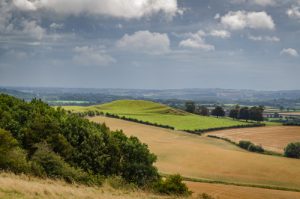
A view of the Lincolnshire Wolds (AONB) Image: Gill Kennett/Shutterstock.com
- Do the Louth Towpath Walk – it runs for 11 miles north along the River Lud to Tetney Haven on the Humber Estuary. The path is a legacy of the 18th century when the River Lud was turned into a canal at Louth. It’s planned to make it a navigable waterway once again in the near future.
- Enjoy The Beautiful Scenery of the Lincolnshire Wolds – is an Area of Outstanding Natural Beauty (AONB) with gently rolling hills and deep valleys, that takes in coastal marshes and dunes. Louth conveniently lies at the eastern edge of The Wolds, which makes it a centre for walkers and ramblers.
Where to stay in Louth?
Most of the available accommodation in and around Louth are inns, guesthouses, lodges and the like. You can expect to pay between £60 to £100 per night for 2 adults sharing. There’s also a good number of holiday lets and chalets. However, these vary greatly in price depending on standard, location and number of available berths.
Thinking of moving?
Are you thinking of moving to Louth? According to the best available information, the average selling price of a property in Louth was £195,100 for the 12 months leading up to December 2020. This represents a fall of around 3% in property prices for the last 12 months when compared to the previous 12 months. The majority of sales during the last year were semi-detached properties, selling for an average price of £173,300. In terms of other property types, flats sold for an average of £99,600, terraced houses for £127,100 and detached houses for £251,700.
